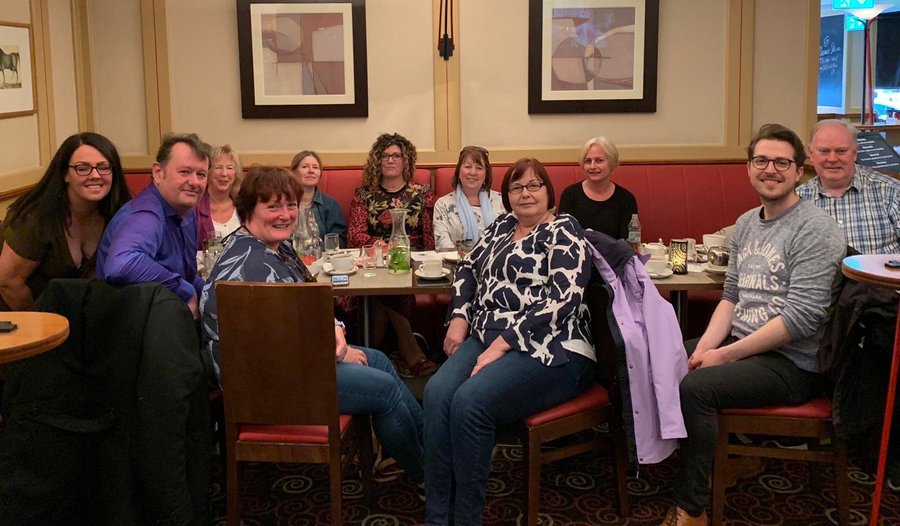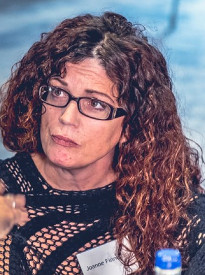Reports
Over the last few years some of us have been travelling the world searching for news of a cure. We have been sharing ocular melanoma specific news from where ever we can get it. In this area of the website we hope to have reports from folks who travel to international gaterings e.g. OcuMelUK & MPNE meetings.
Aug 2019 - Patient & caregiver informal summer meet up - REPORT
 Saturday at 2:30 PM
Saturday at 2:30 PM
Toddy's Bar & Brassarie, The Gresham Hotel, Dublin. Directions via Google maps HERE Telephone contact on the day 0858521505.
Report:
Ocular Melanoma Ireland members (patients & their loved ones) traveled from around the country this weekend for the first ever " Summer Saturday" meet up at the Gresham Hotel, Dublin.
Members said they felt supported in this relaxed space where all felt they could safely share their own personal experience of this rare cancer ( and gain from others experiences on this journey). Ocular Melanoma Ireland continue to commit to being at the forefront of engaging with all sectors including the international and national medical and research community. However, Ocular Melanoma Ireland place prime importance on facilitating a space and time where patients and caregivers can gather, so as to share, to identify, to support and learn from each other.
Ends2017 Opthomology Ocology Research meeting held in the RVEEH, Dublin.
Research presented at home in 2017 includes the following.
In June 2017 an opthomology oncology research meeting was held in the Royal Victoria Eye & Ear Hospital (RVEEH) Dublin. Chaired by Mr Noel Horgan and focusing on Ocular/Uveal Melanoma. We are very fortunate that RVEEH has recorded some of the speakers & has hosted those videos on the interent. We have some video links below & will publish more if & when we get them.
Guest speakers included;
Professor Susan Kennedy (consultant Pathologist St Vincent’s hospital)
Dr Fiona Roberts (Consultant Pathologist, Glasgow Iniversity Hospital)
Professor Heinrich Heimann (consultant ophthalmic Surgeon & Ocular Oncologist,Liverpool university hospital)
Dr A Singh (professor of Opthamology Cole Eye Institute, Cleveland, Ohio )
Video (x2):
Diagnosis of OM: http://video.researchfoundation.ie/2017_frontiers_in_ophthalmology/Professor_Arun_Singh-Diagnosis_of_Uveal_Melanoma/Professor_Arun_Singh.html
Genetics of OM: http://video.researchfoundation.ie/2017_frontiers_in_ophthalmology/Professor_Arun_Singh-Genetics_of_Uveal_Melanoma/Professor_Arun_Singh.html
Professor Gullo (Consultant medical oncologist , st Vincent’s hospital )
Video: http://video.researchfoundation.ie/2017_frontiers_in_ophthalmology/Professor_Giuseppe_Gullo/Professor_Giuseppe_Gullo.html
Professor Crowne Consultant Medical Oncologist St Vincents Hospital)
Ocumel UK Patient Conference REPORT 22/9/ 2017

Ocumel UK Patient Conference 22nd September 2017 Reading, UK
Report by Joanne Finnegan for OcuMel IRL
Dr Paul Nathan, Medical Oncologist from Mount Vernon Cancer Centre, Northwood
Highlighted how immunotherapy does work well for cutaneous (40% and higher) but not so for uveal melanoma.
Current clinical trial operating in the UK
IMCGP 100 - Mount Vernon & Clatterbridge (Liverpool)
Chemosaturation - Southampton
Selumetinib
Paul Nathan advised “patient must be strategic” when choosing a clinical trial and when choosing treatments offered. Patients he said must be offered a strategy by their team to allow maximum choice. Melanoma is not the same condition across different anatomical sites. He explained that all of the centres have trials to offer and each one of them can refer to the other depending on what the patients needs are. UK centres communicate with each other as a network
Prof Christian Ottensmeier, Consultant Medical Oncologiest University Hospitals Southampton
Immune system
- Talked about Til Therapy - 40% response rate (not for OM for another cancer)
- Stated that cutaneous melanoma and uveal melanoma are biologically very different
- With Um there is a lower importance placed on ultra violet exposure.
- Cutaneous has many many mutations – Uveal has only a small number of mutations
- Check point inhibitors – “relatively ineffective with uveal melanoma”.
- T cell therapy “shows potential”.
- “We need to be smarter about how we use the immune system”.
- Immune systems – “we all have different immune systems”
Dr Neil Steven, Consultant Oncologist University of Birmingham
Challenges in treating Uveal Melanoma.
Pointed out that there are specialist OM centres in the UK and that each centre forms a network. Every new patient is discussed at a network meeting. Not useful if all patients he says are sent directly to Southampton initially
Dr. Brian Stedman, Consultant Interventional radiologist, Southampton
Interventional Oncology and its role in liver metastatic disease
Tumor biology – Occular melanoma very different to cutaneous “Think of it as a separate disease”. When it spreads 80% of the time it will go to the liver
Screening/Surveillance
Dr. Stedman is in “no doubt that MRI is the better” method of imaging. Ultrasound technique – “depends on who is actually doing it and small disease can be missed” he says. He talked about mri with contrast and advises with new MRI machines it may no longer be required as there are techonologically so powerful. He feels there can be further discussion re same.
Liver directed therapies available are;
- TACE (small disease that is unresectable)
- Chemostauration/delcath
- SIRT (if delcath is not an option)
- Radioembolization
Liver directed treatment is he says is “buying time” for the patient. Unfortunately delcath/chemosaturation is not yet available on the NHS. Focus Trial is ongoing (6 treatments 6 weeks apart)
Professor Sarah Coupland, NWCR Centre University of Liverpool
Update on collaborative international research efforts in Uveal melaonoma
Dr Coupland firstly talked about the TCGA (The Cancer Genome Atlas) inter project established in 2005 by American president George Bush at a cost of 250 million. Set up to look at solid cancers and genetics of tumors. Its aim was to improve the diagnosis and treatment of cancers. In 2013 its first publication appeared. Uveal Melanoma “was an after thought as there was some monies left over”. Found that there are very few mutations in the tumor of Uveal melanoma.
Project – UM cure 2020 is an EU lead project
- 5 year project
- 12 partners
- Creating a biobank (12 centres)
- Liverpool have made their submission
- 77 ennucleations
- 3 local resections
- 20 had mets at the time of analysis
Joanne asked why the cutaneous support group are on the board rather than an OM patient group and was told that ocumel Uk were approached but at that time they were not in a position to come on board. So MPNE were asked if they wanted to be involved and did so.
Of note
- BAP 1 is seen in 83% of UM
- 4 groups of tumors
- 3 plus PRAME
- Mutation s - again as stated above very few mutations in UM - ONLY 9 EXAMPLE - COLON CANCER HAS 100 MUATIONS
TCGA study of uveal melanoma reveals prognostic subtypes
In a comprehensive, multiplatform analysis of 80 primary uveal melanoma (UM) tumors, researchers of The Cancer Genome Atlas Research Network identified and characterized four distinct subtypes that have unique genomic aberrations, gene expression features, and patient outcomes. Cancers of the uvea, the pigmented middle layer of the eye, are relatively rare and have not been previously well-studied. Up to 50% of UM patients develop metastatic disease, for which there are no effective therapies. This study, published in Cancer Cell on August 14, 2017, suggests that the four subtypes uncovered, each with unique molecular pathway changes and associated clinical prognoses, may require different therapeutic strategies.
The researchers deployed a range of sequencing technologies and novel analytical approaches to characterize molecularly and clinically distinct subtypes of UM. Notably, using DNA-seq and RNA-seq reassembly, they identified multiple novel and complex alterations of the BAP1 gene that otherwise would not have been found. These BAP1 alterations, along with global DNA methylation profiling, can distinguish the previously known disomy 3 (D3-UM) and monosomy 3 (M3-UM) subtypes of UM, which carry more and less favorable prognoses, respectively. Within M3-UM, the investigators found that genomic aberrations, gene expression characteristics, and immune profiles further divide the group into distinct clinical outcomes. The researchers also refined the D3-UM subtype: they identified mutually exclusive EIF1AX- and SRSF2/SF3B1-mutant tumors with distinct somatic copy number alterations and DNA methylation profiles that may contribute to different prognoses. These subtypes may aid in stratifying patients based on the aggressiveness of their disease. Overall, this study expanded our basic understanding of a rare, deadly disease and revealed novel genomic characteristics that may guide the development and application of tailored clinical strategies for UM subtypes in the future. TCGA is a collaboration jointly supported and managed by the National Cancer Institute and the National Human Genome Research Institute, both parts of the National Institutes of Health.
Determined that uveal melanoma is molecularly distinct from cutaneous melanoma, with a lower somatic mutation density, no ultraviolet radiation mutational signature, and a discrete set of significantly mutated genes
See https://cancergenome.nih.gov/newsevents/newsannouncements/uveal-melanoma...
Genetic testing
Talked briefly of liquid biopsies
Joanne asked about genetic testing samples from Dublin to Liverpool. Sarah advised she is not understanding why the samples do not go to her lab. There is more testing done there and more frequent so better trained etc.
Joanne asked about Irish patients getting tested fr MRPA at 38:40 in the video. The presentation is rather a god one to watch.
Dr Heimann Consultant Ocular Oncologist, University of Liverpool
Damato developed the service
Centres are; Glasgow, Liverpool, Sheffield and London Biopsy is done after radiation. Fine needle biopsy not recommended – this is however done in America
Nevus - Watch wait or treat – discussion ensued
Monosomy 3 can be found in a small tumor
No guidelines for low risk OM
Recommends dilation for the population
ENDS